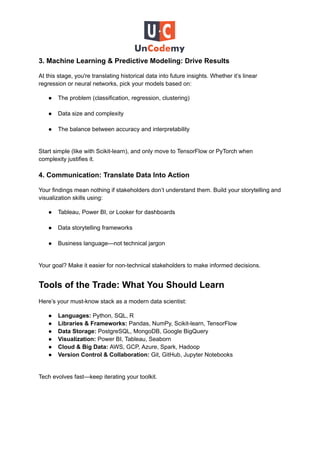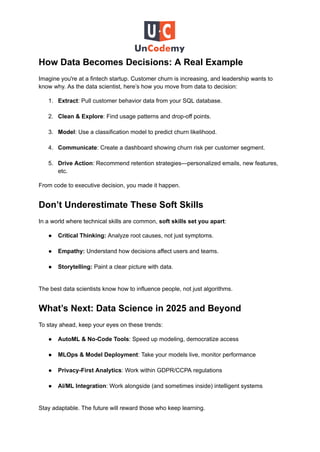From Data to Decisions_ A Complete Guide for New-Age Data Scientists.pdf
- 1. From Data to Decisions: A Complete Guide for New-Age Data Scientists Turning data into decisions is no longer a luxury—it's a necessity. Whether you're building predictive models for customer behavior, creating dashboards for executives, or fine-tuning algorithms for real-time personalization, data scientists today are at the front lines of business intelligence. This guide is built for the new-age data scientist—the hybrid professional who doesn’t just analyze numbers but turns them into insights that drive real-world action. This isn't just about crunching datasets. It's about knowing what to analyze, why it matters, and how to communicate findings so clearly that business leaders can act on them confidently. If you're aiming to build a meaningful, high-impact career in data science, this guide will walk you through the tools, skills, and mindset you'll need to succeed.
- 2. The New-Age Data Scientist: Not Just a Number Cruncher Data scientists today wear many hats. You’re expected to move between raw data and boardroom discussions, between writing code and writing executive summaries. The shift is clear: companies no longer want someone who can just build models—they need someone who can solve problems, predict outcomes, and influence decisions. New-age data scientists are strategic thinkers, fluent in both business and tech. That’s what sets them apart. Core Foundations: What You Need to Master Let’s break down the essential pillars of modern data science and what they mean in practical terms. 1. Data Collection & Cleaning: Where It All Begins Real-world data is messy. Your ability to clean, structure, and prepare datasets determines the accuracy of your insights. Master tools like: ● SQL for querying databases ● Pandas & NumPy for data manipulation ● APIs and web scraping for custom data collection Tip: Clean data isn’t exciting—but it’s 80% of the work, and the foundation of every great model. 2. Exploratory Data Analysis (EDA): Discover the Story Once your data is ready, EDA helps you understand trends, distributions, and outliers. Use tools like: ● Seaborn, Matplotlib for visual exploration ● Correlation matrices and summary statistics ● Domain-specific assumptions to guide deeper questions Think of EDA as your data’s first interview—it reveals what you're working with and where the opportunities lie.
- 3. 3. Machine Learning & Predictive Modeling: Drive Results At this stage, you're translating historical data into future insights. Whether it’s linear regression or neural networks, pick your models based on: ● The problem (classification, regression, clustering) ● Data size and complexity ● The balance between accuracy and interpretability Start simple (like with Scikit-learn), and only move to TensorFlow or PyTorch when complexity justifies it. 4. Communication: Translate Data Into Action Your findings mean nothing if stakeholders don’t understand them. Build your storytelling and visualization skills using: ● Tableau, Power BI, or Looker for dashboards ● Data storytelling frameworks ● Business language—not technical jargon Your goal? Make it easier for non-technical stakeholders to make informed decisions. Tools of the Trade: What You Should Learn Here’s your must-know stack as a modern data scientist: ● Languages: Python, SQL, R ● Libraries & Frameworks: Pandas, NumPy, Scikit-learn, TensorFlow ● Data Storage: PostgreSQL, MongoDB, Google BigQuery ● Visualization: Power BI, Tableau, Seaborn ● Cloud & Big Data: AWS, GCP, Azure, Spark, Hadoop ● Version Control & Collaboration: Git, GitHub, Jupyter Notebooks Tech evolves fast—keep iterating your toolkit.
- 4. How Data Becomes Decisions: A Real Example Imagine you're at a fintech startup. Customer churn is increasing, and leadership wants to know why. As the data scientist, here’s how you move from data to decision: 1. Extract: Pull customer behavior data from your SQL database. 2. Clean & Explore: Find usage patterns and drop-off points. 3. Model: Use a classification model to predict churn likelihood. 4. Communicate: Create a dashboard showing churn risk per customer segment. 5. Drive Action: Recommend retention strategies—personalized emails, new features, etc. From code to executive decision, you made it happen. Don’t Underestimate These Soft Skills In a world where technical skills are common, soft skills set you apart: ● Critical Thinking: Analyze root causes, not just symptoms. ● Empathy: Understand how decisions affect users and teams. ● Storytelling: Paint a clear picture with data. The best data scientists know how to influence people, not just algorithms. What’s Next: Data Science in 2025 and Beyond To stay ahead, keep your eyes on these trends: ● AutoML & No-Code Tools: Speed up modeling, democratize access ● MLOps & Model Deployment: Take your models live, monitor performance ● Privacy-First Analytics: Work within GDPR/CCPA regulations ● AI/ML Integration: Work alongside (and sometimes inside) intelligent systems Stay adaptable. The future will reward those who keep learning.
- 5. Final Takeaway: You’re Not Just a Data Scientist—You’re a Decision Architect "From data to decisions" isn’t just a phrase—it’s the reality of what modern data scientists are expected to deliver. You’re not just cleaning data or building models; you’re architecting paths that businesses will walk on. And if you're just starting your journey or looking to upskill, consider enrolling in a Data Science Training Course in Noida Delhi, Lucknow Nagpur and other parts of India. A strong foundation in real-world tools and techniques can make all the difference as you work to turn raw data into smart, impactful decisions.




